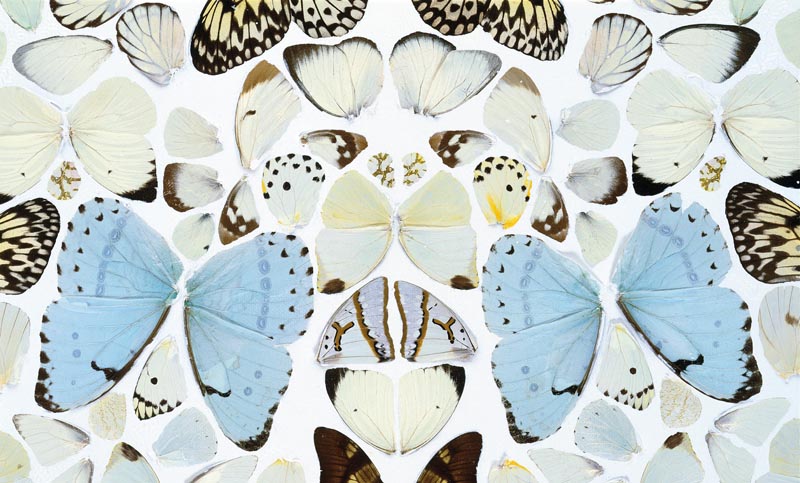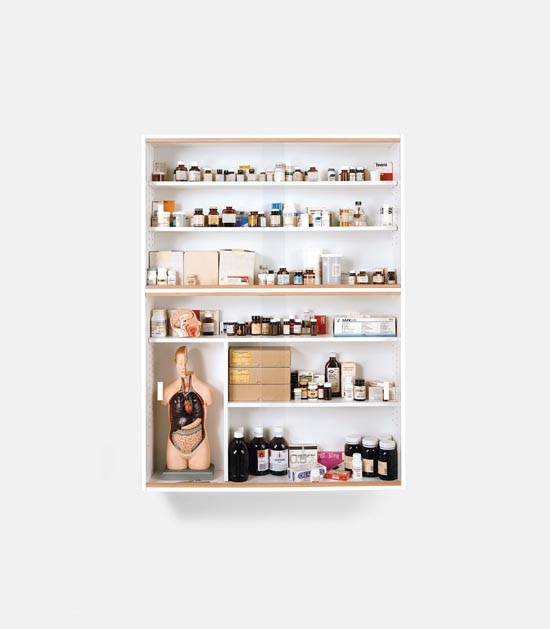DAMIEN HIRST EXHIBITION
HAPPENINGText: Mike Sullivan
In room four ‘The Acquired Ability to Escape’ (1991) and ‘Dead Ends Died Out’ (1993) can be seen, the first consists of a desk, ashtray and cigarettes within a vitrine evoking a sense of distance, yet containment, and for myself also a sense of loneliness and frustration. The second work is made of a number of shelves with cigarette butts which are suggestive of extinction. Rooms five and six contain one of the more touching exhibits ‘In and Out of Love’ (1991), a room where real life becomes art as beautiful butterflies fly around the room, feed on flowers and sugar water and mate. The room next door consists of coloured canvases embedded with dead butterflies and tables with ashtrays full of cigarette butts which remind us of life and beauty, as well as the ugly nature of death.

Damien Hirst “Sympathy in White Major – Absolution II”, 2006 (Detail). Butterflies and household gloss on canvas. © Damien Hirst and Science Ltd. DACS 2012. Photographed by Prudence Cuming Associates
Room seven is a continuation of the ‘Medicine Cabinets’ which aims to bring a pharmacy into the confines of a gallery while room eight holds the Spin Paintings; canvases that were put onto a turntable and had different coloured paints poured on to them. The resulting paintings express a freedom and joy in colour, colour that isn’t limited to certain shapes but allowed to just be free colour. In room eight the sculpture ‘Loving in a World of Desire’ (1996) can also be seen, a giant beach ball hovering above a large coloured box.

Damien Hirst “Sinner”, 1988. Glass, faced particleboard, ramin, plastic, aluminium, anatomical model, scalpels and pharmaceutical packaging. © Damien Hirst and Science Ltd. DACS 2012. Photographed by Prudence Cuming Associates
The following room has more quite controversial art in the form of ‘Mother and Child Divided’ (1993) where a cow and a calf have been cut in half with each half in a separate tank. Many people walk between the separate halves and look in fascination at the organs and flesh which are shown. However, for some, including myself, it is a bit too much. ‘Crematorium’ (1996) can also be seen; a very large ashtray full of cigarette butts and ash which is another reminder of death. In room ten Hirst continues the theme of medicine and pharmacy with surgical instruments and teaching aids while room eleven returns to his use of butterflies. Religion is combined with beauty as dead butterflies have been arranged into beautiful complex patterns similar to church windows while in the centre of the room a sculpture of white marble appears to be a perfect angel from one angle, but internal organs can be seen from a different angle.
In the final rooms the ‘Black Sun’ (2004) has a striking presence but on closer inspection it is clear that the artist has used dead flies to cover the surface providing a pointed contrast between the life that the sun brings and death. Other exhibits include ‘Black Sheep’ (2007) and ‘Beautiful Inside My Head Forever’ (2008) as well as ‘The Incomplete Truth’ (2006) ; a dove suspended in mid-flight which reminds us of many ideas such as peace, the Christian Holy Spirit and as a messenger of hope, yet the dove is dead and will never fly again.
Damien Hirst exhibition
Date: 4th April – 9th September, 2012
Open: 10:00 – 18:00 (Friday and Saturday till 22:00)
Place: Tate Modern
Address: Bankside, London SE1 9TG
Tel: +44 (0)20 7887 8888
https://www.tate.org.uk
Text: Mike Sullivan
Photos: Courtesy of Prudence Cuming Associates, © Damien Hirst and Science Ltd.





